The Sacred Rats of India

Rats abound in India... some of them are welcome, some of them not; some of them are considered holy, some of them are seen as pests. The Vermin Brewing International Research Team was fortunate to be able to view rats at every point in the spectrum.
The lowliest of these poor creatures were seen scurrying among large sacks which were resting on the floors in various roadside tea shacks. Clearly these rats lived a dangerous existence in competition with man. On the other hand, it would almost be hard to imagine that a person would harm a rat scampering along the ghats (docks) of the holiest river in India, the Ganges... especially after the little critter had dunked and washed himself in the holy water along with hundreds of other worshipping Hindus.
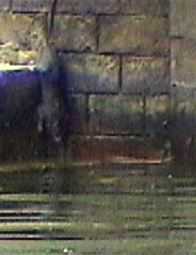
This rat is just taking a quick dip in the holy Ganges River
For whatever reason, other rats have been dealt a far better "paw" in life. In the small city of Deshnoke, located about 15 miles (30 kilometers) south of Bikaner in the northwestern province of Rajasthan, the people believe that the rats who live in a certain temple are holy and will be reincarnated into mystics and sadhus (holy men) in their next lives. Devotees travel for many miles through the Great Indian Desert to pay tribute to these little creatures living in the Karni Mata temple (or Shri Karni Mata).
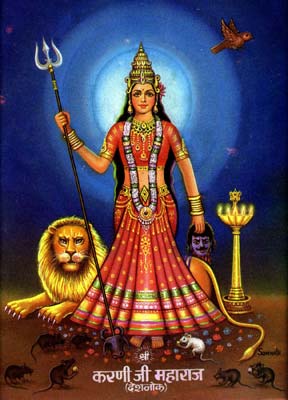
the Hindu goddess Karni Mata
After passing through the great silver doors embossed with the images of rats, one crosses the main courtyard and enters the inner temple complex. It is not the lovely, carved-marble facades that first catch one's eye, but rather all the small brown rats... everywhere... bounding across the ground, feasting from large dishes of grain or milk, scurrying up the pillars and scrambling in the bird nets overhead. We, as tourists, were not allowed to actually enter the inner shrine but were allowed to watch the locals as they gingerly fed the rats and carefully touched the floor where the rats had walked.
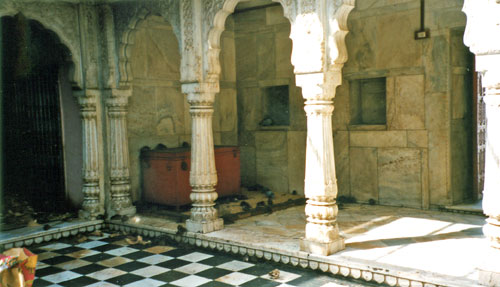
a view of the inner courtyard
The rats themselves are classified as "black rats" (Rattus rattus) and are not the standard pet "brown rats" (Rattus norvegicus), although these rats were probably more tame than many household pet rats. They did not dart away when someone approached because they knew the person would always stop and give them the right of way. Some of the larger rats did look rather 'weathered' with tufts of fur missing or a broken tail, but all in all, they appeared to be quite well-fed and active. One of the local temple caretakers explained that there had been a recent epidemic in which a large portion of the rat population had died; apparently there had been many many more rats only two years ago. Among the remaining rats were still four or five special white rats. Supposedly to view one of these creatures brings very good luck... and the Vermin Brewing Team was lucky that day. But just in case one's luck wasn't so good, however, there were plenty of souvenirs available with the white rat as the star.
For a complete temple experience, see further down...
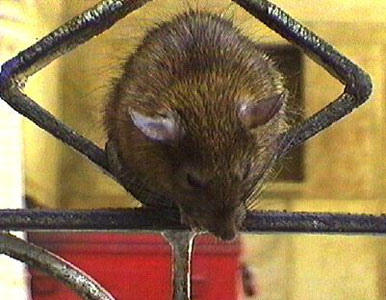
a rat rests on the banister
Rats could be seen all over the country in forms other than the flesh as well. Rats are the honored animal accompaniment of Ganesh, the Hindu god of wisdom depicted with an elephant head. Wherever one finds an image of Ganesh, one also finds a tiny image of a rat by his feet whether it be in wall paintings, stone and wooden carvings, metal statues, or printed in batik. There was even an ample-sized painted wooden statue guarding the hallway in a hotel in Jaipur. More can be read about rats as a companion animal in "Sacred Animals of Nepal & India" (ISBN - 974-7315-23-8).
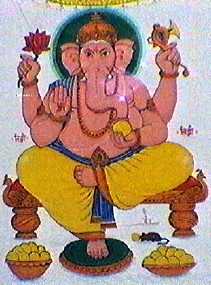
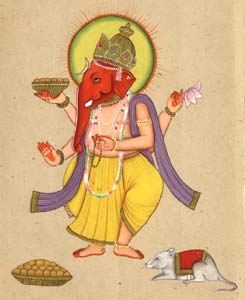
So whether rats are perceived as good or bad, as friends or as foes, they can be found in every last corner of India (well, northern India at least). Bu in order to truly be a part of a world surrounded by rats, one must simply... go to India.
![]()
The Karni Mata Temple
JOURNAL REPORT EXCERPTS
The dry desert air blew on my face as I looked out the window of the white mini-van. I was thousands of kilometers from home, driving through the Great Indian Desert in the northwestern province of Rajasthan. We had been travelling through India for two days in order to visit one of the greatest sites a rat owner could imagine... Shri Karni Mata, the holy rat temple in Deshnoke.
Fortunately it was February, so the weather was not too unbearably warm. The blue hazy sky was filled with scattered clouds. The bright sun still made me squint, however, as it reflected on the sandy beige desert with its sparse grey-green chaparral and caused water mirages to sparkle on the road in the distance. There were not too many people around, just an occasional small caravan of camels pulling large heavily laden, wooden carts. The big lumbering beasts were quite a contrast to their companions - men in brightly colored turbans and ornately dressed women with veil covered faces. The sights were mesmerizing but every now and then I was snapped back to reality as we swerved suddenly to avoid hitting a crossing holy cow or a stray hungry dog. Sometimes the small two-lane road narrowed even further as a sand dune slowly snaked its way across.

When we finally saw a sign for the temple, we realized we were close to our goal. Fortunately for us, this was one of the few signs written in English as well as in the Hindi script of Devnagri. As we turned off the main highway, Mukesh, the driver whom we'd hired for two weeks, began to tell us a bit about the temple. He explained that 'Shri' means 'temple' and that Karni Mata is a Hindu goddess ('Mata' meaning 'mother'). Karni Mata is an incarnation of Durga, the goddess of war who is often pictured riding a tiger or carrying a severed head. We learned that a male rat is called a 'chuha' (pronounced "chew-ha") and a female rat is a 'chuhiya' (pronounced "chew-he-ya"). He went on to inform us that there are not as many rats in the temple this year as there were two years ago. Apparently they suffered from some kind of epidemic and a majority of them died. According to our guide book, there were once over 20,000 rats living there.
We further read that the people believe these holy rats will be reincarnated into mystics and sadhus in their next life. Another source, however, claimed that the rats are children (or 'kabas') who died in a fever epidemic during the 14th or 16th century. After receiving a plea from the grieving mothers to bring the children back, Yama (the god of death) promised that the soul of every child would live on in the form of a rat.
The time for discussion came to an end, however, as we pulled up to a huge red wall with a bright white entrance gate. We parked the car, fought our way through some beggars and went in.
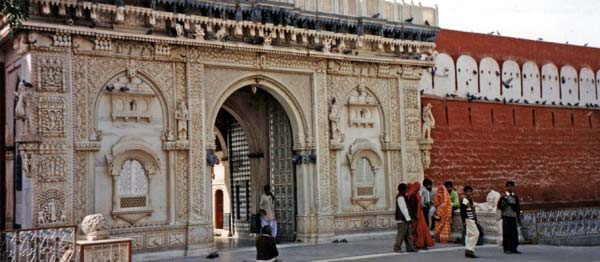
the main entrance gate
The first thing to meet the eye were a pair of large pure silver doors engraved with various rat images, such as the goddess Karni Mata surrounded by many tiny rats or the elephant-headed god Ganesh who is also associated with rats.
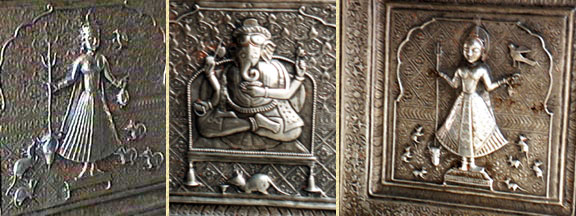
silver images of Karni Mata and Ganesh
We paid our small entrance fee along with a small camera and video camera fee, and entered into the large outer courtyard of the complex. There were plenty of places to explore outside, but we headed right for the main temple first.
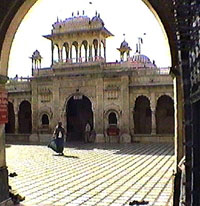
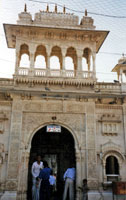
the outer courtyard and the gate which leads to the inner courtyard and the sacred temple
Here, we encountered so many wonderful things that it was hard to decide what to look at ... all the rats scurrying and scampering about or the lovely white marble temple itself. Everywhere I looked, tiny to medium-sized brown rats swarmed about. Since they are from the species Rattus rattus (the smaller black rat) and not Rattus norvegicus (the brown rat and our standard pet rat), they all appeared to me at first to be so small and frail. But I later realized that this was not at all the case. Many of these rats were full of energy, and they bounded, scampered and played with each other just like my pet rats at home. Granted some of them looked quite beaten up with tuffs of fur missing or broken tails, but their daily diet seemed to keep them overall fairly healthy. There were several large bowls distributed around the inner court of the main temple; some were filled with water, others with grain, one with milk, and every bowl had a thick ring of rats around... and yes, often even in... it.
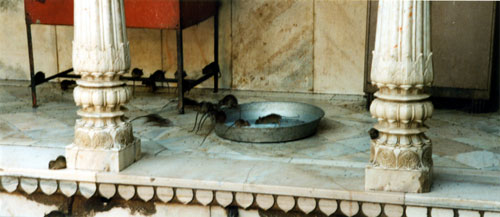
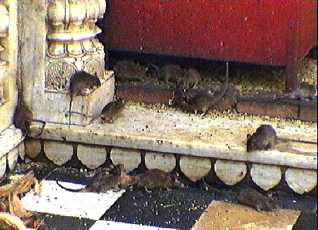
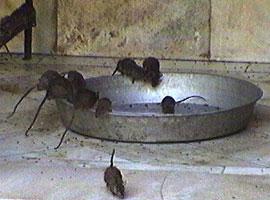
As I continued to make my way through the inner court area, I began to notice the lovely carved white marble of the temple. Beautiful flowers and designs filled every corner. Even the Hindi text chiseled into the walls looked like art. The actual shrine was located inside a small room, hidden behind another pair of lovely engraved silver doors, which we later read were donated by Maharaja Ganga Singh.
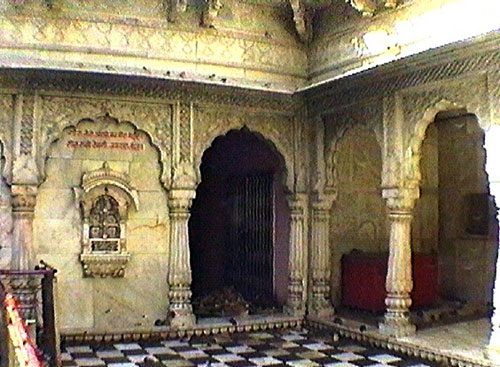
a view of the far right corner of the courtyard
Technically we as tourists weren't allowed to enter the shrine but we were heartily encouraged to take plenty of pictures and video. Just inside the door on the floor was a large plate of sweet yellow globular food (called "legdu", I believe. It is the same food that Ganesh is often depicted eating). Next to that was a small plate of prasad, an equally sweet candy-like food with a similar appearance except in white. A bit further back was another plate of grain. Devotees were gladly offering the rats food from their hands, because if a rat accepts a piece, it is considered to be very good luck. The walls were covered with various drawings and images of rats and Karni Mata. Upon entering the shrine, temple visitors would ring a bell that hung overhead, chant a few words, then repetitively and humbly touch the floor, the many pictures, and the shrine statue itself.
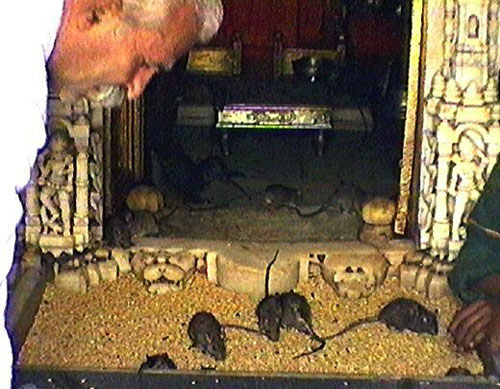
view into back antechamber
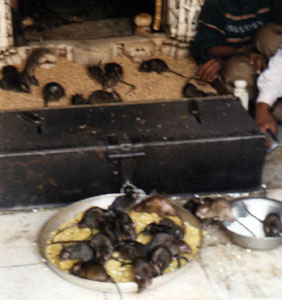
We exited the main temple and headed back out into the large complex located within the huge red wall. Unlike the inner main temple, most of this area was rather run down. It was comprised of an odd combination of statues, small shrines, enormous brass bowls, and buildings which were painted in very bright colors ranging from hot pink to bright sky blue. Overhead hung a large net designed to keep the pigeons out. It covered the entire courtyard, but it was not working very well; pigeons were everywhere. And where there are pigeons, there are traces of what pigeons leave behind. At first that may not seem very important, but just like at any other holy temple, we had to take our shoes off to enter this one as well. We were prepared, however, and had brought "temple socks" (a.k.a. very old socks we didn't care too much about). We later decided we didn't really need them because in most areas it was relatively clean. It was interesting to note that any mess that did exist was due solely to the birds and not the rats. Then again, even the man who sold us the entrance tickets did mention that there were far fewer rats than normal.
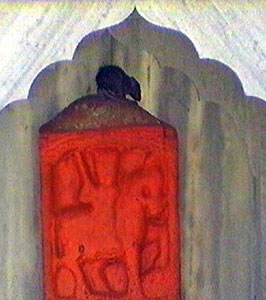
perched atop a shrine
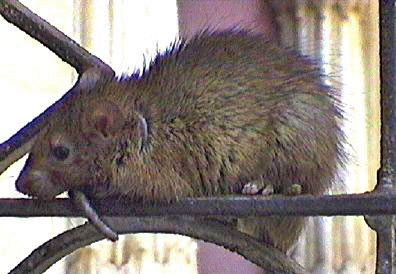
We continued to wander around. Throughout the complex, rats could be found everywhere and at every level; they were eating in the corners, climbing up pillars, walking along fences, sleeping in the overhead net, etc. A person also had to be careful when walking, because clearly these rats knew they were holy and often demanded the right of way. Perish the thought should I kick a sacred rat. A few of the rats around the complex looked a bit sick but that could also have come from the increasingly warm weather. I attributed the frequent bent or crumpled tails and torn ears to the usual rank scuffles that occur over a lifetime when hundreds of rats live in a relatively small area. We admired some rats playing in a smaller side temple and then stopped to watch an old woman carefully feeding a small group of rats from a dish. She bent over them dotingly and it seemed as if she were making sure that every rat got enough to eat.
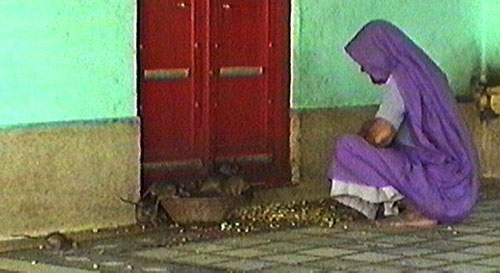
It was the little beggar girl, who had followed us since the moment we had walked in, who was the first to spot the famous white rat. Actually I thought he looked more beige in color, but the story goes that any one who sees one of the four or five white rats that live in the temple will have very good luck. It was fairly obvious that most of the locals believed this story because within moments a huge crowd (we were the only two tourists at the time) had flocked to get a glimpse of the special animal.
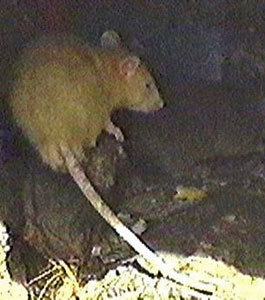
Eventually we felt it was time to leave this most unusual place. As we were on our way out, two other obvious tourists were just entering. Clearly the temple was set up to deal with tourists in that prices were posted in English and there was even a sign out front telling visitors not to give any money to the beggars who hung around in droves. That said, it was also very clearly a place of worship, and we witnessed many people coming to pray who seemed very serious in their offerings and chanting.
There did not seem to be much else in the tiny desert city of Deshnoke other than a souvenir stand where one could buy the exact same pictures found on the sacred shrine walls. They were unbelievably inexpensive and we would have bought many more than we did had it not been for the fact that we had to carry them with us for another three weeks. Again, these souvenirs were not just meant for us but also for the locals. Our hotel owner had asked Mukesh to bring him back one of the smaller-sized pictures (later upon receiving it, he promptly prayed to it; not to mention he was extremely impressed to hear that we were fortunate enough to have seen the white rat).
And so, as we drove back out into the desert, I looked back one last time to watch the temple disappear into a hazy sandstorm. I will probably never again get the chance to visit the Karni Mata temple in Deshnoke, India, but it is nice to know that I was fortunate enough (in this life) to be able to experience perhaps the holiest rat place on earth.
![]()
![]()
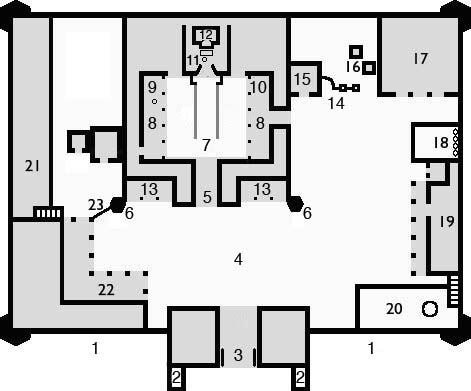
1: outside red wall
2: marble lions
3: silver doors
4: outer courtyard
5: gate to inner courtyard and temple
6: wide corner pillars
7: inner chequered courtyard (banisters down the center kept people from walking about)
8: raised arcade with carved marble pillars
9: milk-dish
10: large grain box
11: inner sanctum and altar
12: antechamber
13: raised patios
14: ornamental fence
15: shrine
16: small shrines with red tablets
17: large shrine building
18: statues
19: building
20: sighting of the white rat
21: large bowls and water-pots
22: woman feeding rats
23: gate






